mudd

Propelling Innovation, Celebrating Community




The College’s official colors were on full display, adding to the festive atmosphere of the two-day inauguration celebration.


 Zoë Gomez-So ’24 and Kathy French ’97
David Nembhard, professor of engineering, and Harriet Nembhard, president
Zoë Gomez-So ’24 and Kathy French ’97
David Nembhard, professor of engineering, and Harriet Nembhard, president



 Walter Naumann ’61 and Dave Howell ’61, P’90
Professors Phil Cha, Erik Spjut P’07, Art Benjamin, Darryl Wright and Susan Martonosi
President Nembhard’s glammed Chucks
Walter Naumann ’61 and Dave Howell ’61, P’90
Professors Phil Cha, Erik Spjut P’07, Art Benjamin, Darryl Wright and Susan Martonosi
President Nembhard’s glammed Chucks




Engineering students

Paula Diehr ’63, P’90 is celebrated for her many contributions to the field of health services research
Ana Studart ’25 supports gender parity in
4 College News
24 Mudderings
27 Class Notes
Opinions about the content of Mudd Magazine are welcome. Letters for publication must be signed and may be edited for clarity and brevity.
This letter, which references the 2023 fall/winter article “Engineering and Socio-Technical Thinking,” is reprinted here with permission of the author who shared it with us.

Members of the HMC community share well wishes and welcoming remarks with President Harriet Nembhard
Leaders discuss the future of
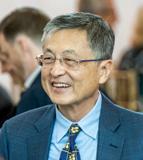
Ho Nam ’88 and President Harriet Nembhard discuss the role of kindness and curiosity in venture capital
Dear Professors Chen and Hoople,
My name is Harvey Mudd II, the grandson of HMC’s benefactor. My father, Henry Mudd, created the College, but the project was based on my grandfather’s vision of a humanistic approach to the sciences. My father shared those values. Harvey Mudd was a businessman, hence the money to donate to education, a man of science, too, a geologist, and a man with a deep conviction about the values of civilization that came through the humanities. He was as comfortable with Shakespeare as he was with ore bodies under the ground. He was also sincere and committed in his belief in the dignity of all human beings. He was a profound human being; not many like him today.
I am a writer and painter. I live in France. In 1970, I was an active environmentalist and gave the commencement address at HMC; Topic: the responsibility of engineers and scientists to the future. I wrote a political blog during the Trump years. Now I write a Substack post on things non-political.
I wish the both of you the very best and am grateful that at least a few of HMC grads follow the original track through the fog.
Harvey Mudd II Grandson of Harvey Mudd, the College’s namesake

Spring 2024 | Volume 24, No. 2
Mudd Magazine is produced three times per year by the Office of Communications and Marketing.
Director of Communications, Senior Editor
Stephanie L. Graham, APR
Art Director
Robert Vidaure
Senior Graphic Designer
Joshua Buller
Associate Directors
Sarah Barnes, Muneeza Tahir
Contributing Writers
Judy Augsburger, Andrew Faught, Dominic Indolino, Arturo Molina, Elaine Regus
Contributing Photographers
Shannon Cottrell, Hannah Dearman-So ’25, Jeanine Hill, Laurie (Hanyi) Luo ’25, Arturo Molina, Nancy Newman
Interim Vice President for Advancement
Kimberly Stafford
Chief Communications Officer
Timothy L. Hussey, APR
Mudd Magazine (SSN 0276-0797) is published by Harvey Mudd College, Office of Communications and Marketing, 301 Platt Boulevard Claremont, CA 91711.
Nonprofit Organization Postage Paid at Claremont, CA 91711
Postmaster: Send address changes to Harvey Mudd College, Advancement Services, 301 Platt Boulevard, Claremont, CA 91711.
Copyright © 2024—Harvey Mudd College. All rights reserved. Opinions expressed in the Mudd Magazine are those of the individual authors and subjects and do not necessarily reflect the views of the College administration, faculty or students. No portion of this magazine may be reproduced without the express written consent of the editor.
Mudd Magazine staff welcomes your input: communications@hmc.edu or Mudd Magazine, Harvey Mudd College, 301 Platt Boulevard, Claremont, CA 91711 magazine.hmc.edu
Follow Harvey Mudd College Instagram, Threads – @harvey_mudd Facebook – @harveymuddcollege LinkedIn – harvey-mudd-college

I’ve enjoyed hosting community members for small gatherings at the President’s House. Cocktail parties have connected HMC faculty and staff with colleagues across the 7Cs, and students with members of my administration. VP/Dean of the Faculty Tom Donnelly and I enjoyed a celebratory lunch—expertly managed by Ramona Campoy, assistant manager, catering/dining services—with recently promoted and tenured faculty and their department chairs (shown).
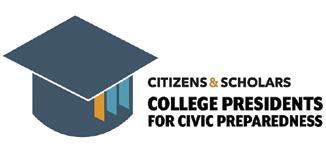
The College has joined the College Presidents for Civic Preparedness, a new initiative convened by The Institute for Citizens & Scholars. Along with other participating colleges and universities, including CMC, I’m dedicated to preparing the next generation of well-informed, productively engaged and committed citizens; defending free expression, civil discourse and critical inquiry as essential civic norms; and increasing thoughtful engagement and better understanding by students for the effective functioning of our democracy. I invite you to read more about this initiative on our news site.
i am grateful for the warm welcome into the Harvey Mudd community. It has been an amazing and full first year serving as your college president, with many opportunities to sponge in this community and express my commitments to it—from receptions on campus and across the country, to a beautiful inauguration. Of course, we are navigating difficult times with the reverberations of the Israel-Hamas war. Even in the face of this unfolding tragedy, we have worked together to learn and grow, and I am incredibly proud of what we have accomplished together.
Thanks to a tremendous community-wide effort, along with the work of the Strategic Plan Steering Committee and the Working Groups, we have accomplished our goal of having a full draft of Propelling Innovation: HMC Strategic Plan 2035 formulated by this spring. Our vision is that Harvey Mudd College will impart a joyful, powerful liberal arts STEM education in a community where the health, wellbeing and success of every individual matters and where a culture of care, collaboration and innovation is fostered. Priorities across three pillars—Honoring Our STEM Mission, The World Needs Harvey Mudd, and A Flourishing Community—elucidate what's next for Harvey Mudd. We look forward to sharing additional information on the plan in the months ahead. Meanwhile, details and updates are available on the HMC Strategic Planning website (hmc.edu/ about/mission-vision).
Throughout the past academic year, we have celebrated some impressive milestones, including the 10th anniversary of the Shanahan Center for Teaching and Learning, a physical embodiment of our vision that has served as a hub for innovation and discovery. Our Hixon Center for Climate and the Environment continues to evolve (learn about two new joint majors on page 4), equipping our students with the tools they need to tackle complex environmental issues. With the addition of new faculty members, we are poised to expand our expertise in climate science and pave the way for groundbreaking research and innovation.
But perhaps most inspiring to me are the traditions that embody our inclusive community spirit, such as Family Weekend, the Hoch Hearts (a community-wide event presented by Division of Student Affairs’ Muchachos) and— especially meaningful for me—the inauguration celebration, which is featured in this issue. These cherished events bring together students, faculty, trustees, parents, staff and alumni from diverse backgrounds, cultivating connections and shared experiences that strengthen the bonds of our College community.
As we face division and difference of opinion on our campuses in Claremont as well as locally and globally, I—along with members of my cabinet—am actively listening and seeking productive ways to build connection and understanding. We are confident that ultimately we can strengthen our community by having dialogue and rigorously contending with multiple viewpoints. We can live up to our mission and values, support safety and belonging, and undergird our civic commitments in a respectful, caring community of scholars.
I am filled with gratitude for the traditions that unite us and the leaders helping guide us forward. Together, we will continue to honor our past, shape our present and chart our course toward a future filled with promise and possibility.
B. Nembhard President Harvey Mudd College
This spring, three strategic planning working groups Imagining Harvey Mudd, Academic Vision, and Student Experience provided the HMC community with several opportunities for feedback. Strengths, opportunities, aspirations and results (SOAR) analysis sessions and conversations with working group representatives are helping determine the values, essence and distinction of HMC. Each working group produced a report focusing on ideas that have the potential to enhance the direction or operations of the College and the education it provides its students. A Steering Committee is assisting President Harriet Nembhard in guiding the planning efforts, ensuring the effective integration of recommendations from the working groups into a strategic plan, an essential element of the College’s upcoming comprehensive campaign.
Strategic Planning details, hmc.edu/about/mission-vision.


octavio gustavo boubion, the first director of Harvey Mudd College’s Upward Bound program, died in March. Upward Bound helps low-income, first-generation prospective college students in the East San Gabriel Valley community build necessary skills for success in college. The Upward Bound program at The Claremont Colleges dates to 1968, when it began at the Claremont University Center. In 1972, the grant was moved to Harvey Mudd College by Founding President Joseph Platt and Dean of Faculty Sam Tannenbaum. As the grant’s project director, Boubion distinguished himself and the grant with a reputation for innovation and creativity.
At the time, such satellite programs and internship models were unprecedented nationally. A first-generation college student himself, Boubion is credited with building Upward Bound into a nationally recognized model of excellence, with summer internship programs in Sacramento, La Jolla and the Sierras to give students exposure to science and technology, politics and policy, and the wilderness. Since the program’s inception, many students from The Claremont Colleges have worked as program tutors, and an estimated 1,000 first-generation, low-income students from local communities have benefited from the program.
Current Upward Bound Program Director Angie Covarrubias Aguilar said, “It is because of Boubion’s ability to reimagine opportunities for first-gen students that we have such an excellent program. Our summer programs alone are unique among other Upward Bound programs in the nation because of Boubion’s creativity and imagination. As a graduate of the program myself, Upward Bound completely changed the trajectory of my education, and I am proud to be a part of his legacy.”
Developed by The Hixon Center for Climate and the Environment and the departments of chemistry and computer science, new joint majors in chemistry and climate and in computer science and climate will be offered starting in the 2024–2025 academic year. Both programs will train students across two disciplines more are planned for other HMC majors. “The idea is for students in any program to be able to study climate,” says Lelia Hawkins, Hixon Center director and Hixon Professor of Climate Studies. “Each of the new joint majors with climate will be designed to help students develop literacy in the climate system and climate change while continuing to pursue depth in one of our existing majors.”
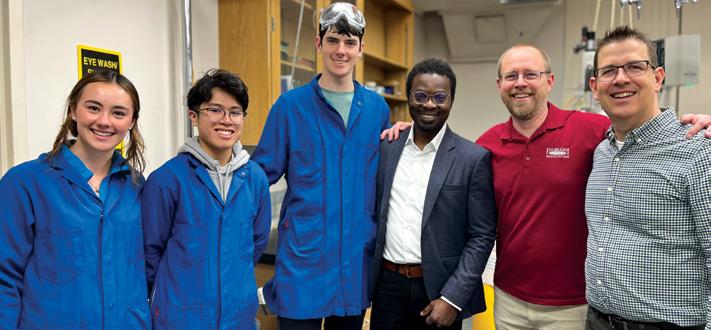
with funding from the camille
and Henry Dreyfus Foundation, the Department of Chemistry recently hosted the distinguished scholar Richmond Sarpong for a two-day visit to Harvey Mudd. The centerpiece of Sarpong’s visit was a public lecture on Jan. 29, “A Life in Chemistry Shaped by Diseases in Sub-Saharan Africa,” delivered to a full house of students, staff and faculty from all five undergraduate Claremont Colleges as well as local community members.
Sarpong described his childhood and the influence of his father, a physician and medical director with posts in Ghana, Nigeria and Botswana. He described the impression made on him by the extraordinary effects of the anti-parasite drug ivermectin, which effectively treats onchocerciasis, commonly known as river blindness.
Inspired by the power of smallmolecule medicines to alleviate human suffering, Sarpong embarked on a career in synthetic organic chemistry that began with a chemistry degree from Macalester College, where he conducted research with Rebecca Hoye, a mentor who had a lasting impact on his career. After completing his PhD at Princeton and a postdoctoral fellowship at Caltech, Sarpong began his academic career at UC Berkeley.
Sarpong highlighted the power of small molecules to act as drugs. He described the role of creativity and analytical reasoning in devising new and more efficient routes to synthesizing known compounds and developing new chemical derivatives that could potentially have even more potency
and fewer side effects. His talk was hopeful and forward-looking about the impact that synthetic organic chemistry can have on human health and the ways in which students can apply their skills to interesting, important challenges.
During a research seminar hosted by the chemistry department and attended by scientists from across The Claremont Colleges, Sarpong delved further into concepts discussed in his lecture. He illustrated his approach for the construction of complex synthetic targets, using several of the molecules that his group had synthesized as case studies. He highlighted his lab’s “break-it-to-make-it” approach to the construction of complex geometries. During his two days at Harvey Mudd, Sarpong also visited Core Chemistry and Organic Chemistry classes and met with students, faculty and administration. A professor of chemistry and executive associate dean of the College of Chemistry at UC Berkeley—where Emily Fok ’22 is one of his graduate student co-workers— Sarpong has received multiple awards for his pioneering work, including the Camille Dreyfus Teacher-Scholar Award and the 2022 ACS Award for Creative Work in Synthetic Organic Chemistry. His visit was made possible through the Jean Dreyfus Lectureship for Undergraduate Institutions program, funded by the Camille and Henry Dreyfus Foundation. This grant program, in addition to bringing Sarpong to campus, will also fund research projects in chemistry for two Harvey Mudd students during summer 2024.
Elected vice chair of the board Michael Schubmehl ’02, board member since 2014
In Memoriam

Engineering alum Jude P. Laspa ’65, an emeritus trustee, former member of the Alumni Association Board of Governors and generous supporter of the College, died Dec. 29, 2023. He served on the board from 1989 to 2010 and was vice chair from 2004 to 2010. He and his wife, Eileen SCR’67, were generous donors of both time and gifts to the College, particularly the Department of Engineering. They established the Jude and Eileen Laspa Endowed Professorship in Engineering, created the Laspa Professors of Practice and supported fellowships in applied mechanics and the autonomous systems. The Laspas supported the development of the makerspace and the relocation and refurbishment of student machine shops. The Laspa Problem-Based Learning Fund (crucial to the development of E79) helped the engineering department provide students with hands-on learning experiences. Laspa was an integral member of the Engineering Leadership Program’s steering committee and advisory board. He received the Alumni Association’s Lifetime Recognition Award in 2015.

Clifford A. Miller died Feb. 16. Miller’s service to Harvey Mudd College was tremendous. He served on the board from 1974 to 2013, including as its fourth chair, and provided support and wise counsel to five Harvey Mudd presidents. He was a founding trustee of the Keck Graduate Institute of Applied Sciences. Cliff and his wife, Judith, were enthusiastic participants in College and board activities. In 2006, Miller was one of the first recipients of HMC’s Lifetime Recognition Award for his dedication to the College.
The Entrepreneurship Workshop course, co-taught by Josh Jones ’98 and Gordon Krauss, Fletcher Jones Professor of Engineering Design, included a spring speaker series to connect entrepreneurs with students.
Mason Plumlee is starting center for the Los Angeles Clippers and has an investment fund and startup. He has also invested in Harvey Mudd student/alumni-founded companies. He discussed his NBA experiences as well as his entrepreneurial ventures.
Lindsay Wray ’08, a material scientist and entrepreneur, has combined her biomedical expertise with a desire to provide innovative biomaterials to consumers. She started out pursuing an education in biomedical engineering, fueled by her passion for biomaterials and stem cells and their prospect for advancing human healing. Wray helped develop product-market-fit for the first-ever vegan spider silk polymer in beauty and personal care. She’s launching a new company (still in stealth mode) harnessing tech that aims to relieve suffering for millions of people with recurrent infections.
Benson Tsai ’06 co-founded Motiv Power Systems and founded Stellar Pizza, a robotic pizza company. He designs luxury electric vehicles at Lucid Motors and builds advanced battery systems for SpaceX. He was the 2023 Pizza Expo keynote speaker and named to Nation’s Restaurant News 2022 Power List.
Jacob Fain ’26 found Tsai’s talk to be “perspective-altering,” particularly the discussion about personal brand, both as professionals and as holistic human beings. “In classes and extracurriculars or the workplace, and in all of our relationships and communities, we must be aware of and uphold that brand,” Fain said. “It consists of the traits that set us apart from everyone else, the things we’re uniquely good at, the ways other people can rely on us, and everything else that makes us who we are. We make who we are clear to others, too, whenever we strive to be our best selves. That is what is at the core of meaningful networking, whether professional or personal.”


For the April 8 total solar eclipse, those in Claremont enjoyed activities to view the phenomenon (partial eclipse here). Pomona College and Harvey Mudd joined forces to provide the community with access to telescopes, solar filters, DIY pinhole projectors, solar spotters and more. Catherine Pilachowski ’71, Daniel Kirkwood Chair and distinguished professor of astronomy at Indiana University and 2021 HMC Outstanding Alumna, shared her expertise on The Academic Minute, “For astronomers, the eclipse is a rare chance to study the lower and middle solar corona, too faint to see during daylight. Schools, libraries and museums along the path will participate in the Citizen Continental America Telescopic Eclipse project to produce an hourlong video of the polarized solar corona for astronomers to study. These observations may help us understand the mechanism that heats the corona to millions of degrees above the sun’s cooler surface.”

“Category theory sort of lifts your feet off the ground and allows you to see things from a 30,000-foot perspective, and that enables you to see connections between disciplines in math that may be imperceptible from the ground level. Category theory kind of takes a Mad Libs, template-like approach, and it’s this approach that allows you to see these different connections.”
Tai-Danae Bradley, from the April 3 Michael E. Moody Lecture, “Category Theory: The Mad Libs of Mathematics.” Bradley is a research mathematician, professor and author.
View talk on HMC’s YouTube channel: bit.ly/moodytalk24
Engineering students make a thrilling discovery
Written by Arturo Molinaduring a chemical science experiment in fall 2022, engineering students JT Griffin’23, Arpita Bhutani ’23 and Evan Flitz POM ’22 made a discovery that could lead to more fuel-efficient flying and driving. The group, mentored by Albert Dato, associate department chair and associate professor of engineering, identified a way to strengthen acrylonitrile butadiene styrene (ABS), a plastic widely used in the automotive, aerospace and electronic device industries, without adding a significant amount of weight to it.
After conducting a similar experiment on epoxy that produced successful results, the team was inspired to experiment with making a polymer that was lighter and stronger.
“The moment of our initial discovery was thrilling,” Bhutani says. “Witnessing such notable deviations from the norm before we shifted the study’s focus only served to strengthen our dedication to the research.”
The team’s research, recently published by the American Chemical Society, explains how they increased the strength of ABS by over 20% by incorporating miniscule quantities of a synthesized graphene, a single thin layer of graphite.
“We all held our breath each time a new sample was being tested,” Griffin says. “When we realized the samples with graphene proved to be stronger than anything we tested, the room exploded with excitement. It felt like the team’s hard work had come to fruition.”
Soon after the discovery, Dato helped prepare the team to present their findings at scientific conferences in Hawaii and Boston, where they described their work and fielded questions from other researchers.
“Engaging with industry experts and peers broadened our perspectives and


brought us closer as a team,” Bhutani says. “While facing challenging questions from seasoned professionals and graduate students was daunting, Professor Dato’s thorough preparation and emphasis on fundamental principles equipped us to navigate these interactions with confidence.”
At Harvey Mudd, Dato researches the synthesis and applications of nanomaterials and directs the Energy and Nanomaterials Lab, in which researchers seek to develop solutions to energy and environmental challenges through applications of advanced materials.
Dato continues to present the group’s findings at conferences across the country and says his students’ growth as independent researchers is what he values the most from this experience.
“They’ll start in the lab and not get great results, but you learn from that and move on to conduct more experiments,” Dato says. “Next thing you know, they’re making this discovery on their own, presenting it to the world and then publishing it in high-impact journals. And that’s what you live for as a mentor, right?”
Dato’s research is supported by a grant from the National Science Foundation.
Biology
“Most of us don’t think about tapeworms much. They’re uncommon in the developed world, and kind of gross,” wrote Eliot Bush in a recent article for Illumination, a publication on Medium.com. Bush’s article explains how studying “the little freeloaders’” evolution via phylogenetic trees and molecular sequence data can reveal secrets of our ancestors’ diets. Understanding when tapeworms began infecting humans can teach us more about human evolution.

Recent trypanosome research by Danae Schulz and several former students has been published in two scientific journals. “Synthesis and characterization of I-BET151 derivatives for use in identifying protein targets in the African trypanosome,” published in Current Research in Chemical Biology, is authored by Becca Blyn ’22, Gracyn Buenconsejo ’22, Eric Tang POM ’21, HMC research technologist Melvin Hodanu, Schulz and students from The Wistar Institute and Thomas Jefferson University. “Chemical Inhibition of Bromodomain Proteins in Insect-Stage African Trypanosomes Perturbs Silencing of the Variant Surface Glycoprotein Repertoire and Results in Widespread Changes in the Transcriptome,” published in the American Society for Microbiology’s journal Microbiology Spectrum, is coauthored by Jennifer Havens ’18, Lindsey Rollosson ’20, Ethan Ashby POM ’21, Schulz and Pomona College mathematics professor Johanna Hardin.
Research by Cathy McFadden examines bioluminescence, a trait that evolved in deep-sea octocorals 550 million years ago and may lead to further applications in biomolecular research. The study, “Evolution of bioluminescence in Anthozoa with emphasis on Octocorallia,” was published in Proceedings of the Royal Society B,
the main research journal of The Royal Society of London for Improving Natural Knowledge.
A grant from Organic Synthesis will support the work of David Vosburg this summer. He and student researchers will continue research this summer to develop a greener way to acylate alcohols and thiols. The project builds on work by Nate Luis ’23 and Kasey Chung ’25 that was published last year in Organic Letters “This funding support from Organic Syntheses reflects the high quality of work Harvey Mudd undergraduates are able to achieve on important research problems and also their strong track record of post-graduation success in chemistry,” says Vosburg.

Climate and computer science professor Lyn Kirabo gave the keynote address at the 12th annual S.E.S.H.A.T. (seeking excellence in science, health, arithmetic, and technology) STEAM Conference for African American Girls at Harvey Mudd. The event, organized by Sacred Sistahs, focuses on encouraging girls to pursue careers with a math and science focus and exposes them to professional women in those fields.
In a Bite of Learning lunchtime speaker series talk, Julie Medero presented “Teaching in the Makerspace,” describing her course for computer science majors that explored the intersection of making and computer science. She also discussed ways she has integrated experiential learning with her teaching.
Change of perspective is ubiquitous in mathematics. Consider, for example, equivalent fractions, change of coordinates, u-substitution, Bayes’ Theorem or even the simple fact that 2 + 3 = 3 + 2. In a lecture for the University of Arkansas mathematics department, Michael Orrison offered reflections on the unifying role that change of perspective plays when we learn, share, create and discover mathematics. He also shared how conversations over the years with teachers, students and his own children have shaped his understanding of the power of change of perspective.
The Laureates Committee at Rice University honored Talithia Williams with a 2024 Distinguished Alumni Award, which honors those who have advanced the interest and standards of excellence of Rice University through distinctive professional or volunteer careers, and, among other purposes, serves to provide role models for current and future students of Rice University.
Humanities, Social Sciences, and the Arts After 30 years in the United States (23 working at HMC), Marianne de Laet (anthropology and science, technology and society) will take a leave of absence during the 2024–2025 academic year to return to the Netherlands where she will direct the Meertens Institute (part of the Royal Netherlands Academy of Arts and Sciences). As a science and technology researcher, De Laet is involved in the social development of natural scientists and engineers. Her expertise covers the fields of anthropology of technology and culture, science and society.
As part of the Bite of Learning lunchtime speaker series, Erika Dyson (religious studies), Ken Fandell (art) and Kyle Thompson (philosophy) presented “Navigating the Use of Generative AI at HMC.” The professors discussed how they are handling the opportunities and challenges of generative AI in their teaching and what excites and worries them about AI in academia.

A multitalented yet little-known figure for gay liberation and antiracism is the focus of an OutHistory fellowship for cultural geography professor David Seitz. Seitz received a $1,500 fellowship from the OutHistory Foundation for an essay project, “Enough is Enough: The Politics, Passion, and Poetry of Pei-Hsien Lim,” to be published in 2025. Lim was a MalaysianChinese-Canadian artist and social justice activist in LGBTQ, PWA (people with AIDS) and Asian North American communities. Seitz’s essay project, accompanied by multimedia artifacts, chronicles Lim’s political and artistic contributions to these movements and considers how Lim’s work enacted social change and influenced contemporary social activism.
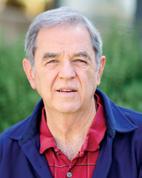

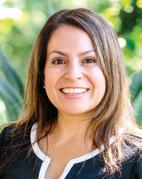

Bill Daub became a chemistry professor at Mudd in 1978 and went on to fill additional roles as Core curriculum director, associate dean for academic affairs, department of computer science chair and associate dean for special projects. Among many fond memories of his time at the College, Daub recounted his “The pH is Right!” class for first years, a takeoff on The Price is Right TV gameshow. Co-hosted with Hal Van Ryswyk and Bob Cave, Daub said the exercise “brought the house down, much to the chagrin of the class going on next door (P-Chem).”
During his 12 years as an engineering professor at the College, Kash Gokli also served as Engineering Clinic director and director of the Riggs Fellowship in Engineering Management. In 2021, he became the College’s inaugural director of entrepreneurship initiatives. Gokli said some of his favorite moments as a professor were when his students presented papers at conferences, won competitions and were recognized for their outstanding contributions and achievements. “Our students amaze me with what they can do, given the opportunity,” Gokli said.
In March, Esther Hughes retired from her role as executive assistant to the VP and dean of the faculty. Hughes began working at HMC in 1998, serving as administrative assistant in the Department of Engineering’s Clinic Program. In 2005, she became administrative assistant for the dean of the faculty and, for the past 18 years, worked with five deans (Danny Goroff, Bob Cave, Jeff Groves, Lisa Sullivan and Tom Donnelly).
Roy Whiteker, founding faculty member and chemistry professor

Roy Whiteker, one of the College’s seven founding faculty members, died Feb.14. He came to Harvey Mudd in 1959 after earning his doctorate in analytical chemistry from Caltech and taking on a postdoctoral appointment at MIT. In his search for a faculty position at a small liberal arts college in the West, he learned of Harvey Mudd College. He wrote to Joe Platt, was interviewed by Art Campbell and joined the latter to establish the Department of Chemistry. Whiteker lived on campus in the College’s first dorm for a time and was a great help to the students, wrote Platt in his book Harvey Mudd College: The First 20 Years. “[Roy] managed remarkable equanimity in the midst of chaos and had the sympathy of the rest of us.”
Wendy Menefee-Libey joined the staff in 2000 as director of learning programs, later becoming senior director. As director of the Writing Center and Academic Excellence Program, Menefee-Libey created a warm, welcoming space where students can develop the critical and analytical tools to become excellent communicators. In addition to the student writing consultants, she oversaw trained peer tutors, who facilitate workshops for HMC’s Core technical courses. She is co-author, with Director of Institutional Research and Effectiveness
Laura Palucki Blake, of the 2017 Association of American Colleges and Universities Peer Review article “How Writing Contributes to Learning: New Findings from a National Study and Their Local Application.” It highlighted the College’s Writ 1 course, part of a campus-wide effort to develop writing and critical inquiry skills and provide students with effective writing strategies and conventions that apply across disciplines. She received the College’s 2024 Mudd Prize, an award that recognizes extraordinary service.

Peter Osgood joined the admission staff in 1998 and has been part of the team that has shaped each entering class since then. He has advised three presidents and three vice presidents of admission and financial aid. A recipient of the 2016 Henry T. Mudd Prize, he was recognized for mentoring junior staff, being a kind role model and leading by example with his dedication to serving as an ambassador for the College. He has served as the liaison between the College and the CMS athletics department and has been an advocate for student athletes in the admission process. Osgood will retire on June 30.
A stickler for accuracy and precision in calculations, Whiteker served on the faculty until 1974 then became executive secretary of the Fulbright Commission, and later dean of the faculty then provost of the University of the Pacific.
Founding class member and chemistry professor emeritus Gerald Van Hecke ’61 shared his remembrances of Whiteker, who gave him the nickname VH. “I was Roy’s first senior research thesis student and worked two summers for him under the NSF Undergraduate Research Participant program … When my career at Shell Development came to an end, Roy, as chair of the department at the time, took a risk and hired me as an assistant professor. As a green, new professor, Roy was a mentor to me, and I remember one piece of advice he gave me: ‘Tell the students whatever you want, but make sure what you say is correct.’”
Ana Studart ’25 looks forward to the day when her efforts supporting gender parity in STEM are unnecessary.Written by Sarah Barnes
ana studart ’25 has had a lifelong passion for mathematics and math competitions. At age 13 she represented her country, Brazil, in a Latin American-wide math Olympiad in Argentina, earning a silver medal. She will always remember when, in ninth grade, she became one of only a few hundred Brazilian students to advance to the final stage of the Brazilian Math Olympiad. This meant she’d have a chance to compete against the best students in her country, and she was determined to do well.
As the competition progressed, so did Studart, steadily advancing from level to level with a winnowing group of students. The day before the last phase of the competition, she went to the library to study with classmates who had also made it to the last phase. As she approached the library’s small study room, Studart could see that it was crowded with students, all boys. One of her peers saw her approaching and stood up to meet her outside the room. “He’s going to say there’s no room for me,” was her thought. What he actually said was, “There is only space in here for people who actually have a chance of doing well tomorrow.”
As the only girl in the advanced math classes at her school, she was used to feeling alienated. Studart does not know if her classmate meant that she didn’t have a chance because she was a girl, but that was the message she internalized.
On the ride home that afternoon, Studart’s mother cheered her up and convinced her to keep going. The next day, she did, earning a silver medal and placing seventh in the competition. That felt good, of course, and made her determined to make more space in this environment, not just for herself, but for all girls.
So, in 2018, Studart and a friend decided to create the environment they sought, and founded the Nonstop Project, in which girls teach STEM subjects to other girls. “It started with a friend and me teaching math to about 20 girls, but it expanded over the years. By 2021,
when I came to Harvey Mudd, Nonstop had directly impacted more than 1,500 girls from all 26 states of Brazil,” she says.
Nonstop began to grow in size (the project now has more than 50 volunteer teachers) and scope, with instruction offered in astronomy, biology, chemistry, physics and programming to more low-income students. To date, Nonstop students have won more than 150 medals in national competitions.
By 2021, the Nonstop Project comprised a growing network of young women who were eager to participate in math competitions, however, a gender barrier remained, as women were vastly underrepresented in those spaces. Once again, Studart decided to initiate a change, helping to create the Pan American Girls’ Math Olympiad (PAGMO) with four other women from Ecuador, Spain, Chile and Mexico. PAGMO has been held now for three years, with about 15 participant countries every year.
With its mission to educate students to be leaders in their fields who understand the impact of their work on society, Harvey Mudd College was attractive to Studart, whose work embodies these ideals. The College’s reputation for gender parity in computer science was also attractive, and, since coming to Mudd, she’s begun to think of these things in broader terms.
“I hadn’t reflected much until recently on how diversity and inclusion in computer science go beyond who is coding to include other aspects, such as who is affected by that code. Some of my classes, especially my Programming Languages course with Professor Lucas Bang, made me think more about what inclusion and diversity mean in these other aspects of CS, which is something I have appreciated in my Mudd education.”
Studart continues nonstop in her efforts to create more space for people in STEM. At Mudd, she’s taken on several mentorship and leadership roles, most recently as co-director of diversity for ASHMC.
While she’s focused on her studies at HMC, Studart is also thinking about how she’ll keep going after college. “I’ve learned a lot of math at Mudd so far, discovered an interest in computer science, fulfilled the dream of doing research and my lab—even got a CS paper accepted for publication,” she says. “All of this made me more excited about STEM in general and made me more determined to keep working on assuring that other women and low-income students can have the same opportunities as I have.”

Harvey Mudd community members gathered this spring to demonstrate that “truncated octahedra work as rhombic dodecahedra” by constructing mathematical art that’s also a vibrant display of unity and community spirit.
At 9 feet tall and 13 feet wide, the yellow, black and white aluminum structure— TOWARD for short—demonstrates a relationship between truncated octahedra and rhombic dodecahedra, two examples of space-filling polyhedra. Each dodecahedron is made up of two connected octahedrons, all of which participating alumni, students, faculty and staff had to fold, connect and assemble.
Peter Kagey, visiting assistant professor of mathematics, said the inspiration for the project came from spending time in HMC’s makerspace. “The makerspace gave me an excuse to go and make all sorts of new kinds of mathematical objects, and, through that, I started getting connected to people online who were creating similar types of illustrations.”
Kagey met Glen Whitney, founder of Studio Infinity, a group that makes large-scale math illustrations and demonstrations, and they decided to bring a project to Harvey Mudd. Math alum Nick Rauh ’06, who had worked with Whitney at the National Museum of Mathematics, was thrilled to help.
“It’s been wild to be back on campus constructing this object,” Rauh said. “We’re

all about getting people to be enthusiastic about math, and obviously most of the people here are already enthusiastic about math, but we hope that some of the other folks who join will share that excitement as well.”
Lydia Stone ’25 was one of the first Mudders onsite to begin building the octahedra. She saw it as a rare opportunity for her and other Mudd mathematics majors. “A lot of times in math, we really don’t get the opportunity to get hands-on with the topics we talk about,” she said. “I’m excited to show friends and family who visit a physical project and structure I got to work on.”
Funded by the Seattle Universal Math Museum, the structure was assembled and nestled in an octagonal area between the Jacobs Science Center and Kingston Hall, where it will be situated for the remainder of the term.
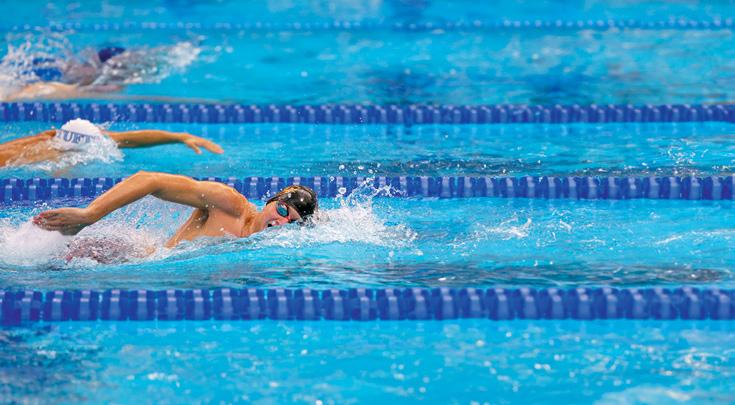
The prize: The most prestigious national award for undergraduate STEM researchers, the Barry Goldwater Scholarship, is aimed at U.S. students who demonstrate exceptional academic achievement and a commitment to pursuing careers in mathematics, natural sciences or engineering. A total of 438 Goldwater Scholars were selected this year from a field of 1,353 students nominated by their academic institutions. The scholarship covers up to $7,500 of college costs.

The recipient: Joint computer science and mathematics major and a grader/tutor in HMC computer science and mathematics classes
Kerria Pang-Naylor ’25 joins 28 previous Harvey Mudd recipients of the scholarship since 1986. In summer 2022, she worked in Heather Zinn-Brooks’ research group to develop and study methods for fitting the parameters of bounded-confidence models with social media datasets. Pang-Naylor analyzed the structure of information cascades and relationship networks on social media and wrote scripts to generate opinion distributions based on probabilistic assignments of trained binary text classification models. In 2023, Pang-Naylor also worked in George Montañez’s research group on two projects involving probabilistic inference and machine learning theory.
Lucas Lang ’25 earned the national championship in the 1650-yard freestyle by a margin of just one sevenhundredths of a second on the final day of the NCAA Division III Swimming and Diving Championships in March. Lang, who was the runner up in the 1650 as a first year in 2022 and fifth in 2023, earned the title by taking 9.33 seconds off of his time this season. Lang’s title makes it three years in a row that CMS swimming and diving has won a national championship.
With teammates Ian Li ’25 and Kishore Rajesh ’24, Pang-Naylor completed a paper that presents a quantitative framework for selective abduction. She’s also working on a project with Eric Chen ’24 involving the study of supervised machine learning algorithms with inductive orientation vectors.
Pang-Naylor says: “I am very thankful for my research advisors Prof. George and Prof. Heather! I would like to pursue a PhD in applied mathematics or computer science with a focus on mathematical data science. I am most excited about research involving machine learning theory, optimization and probabilistic inference.”


Members of the HMC community share well wishes and welcoming remarks with President Harriet Nembhard
“Having attended larger universities, I’ve been impressed by how much the Mudd community cares for each and every member. Seeing you with your smart, warm and generous family made me feel that Mudd was now just an extension of that family. I know we will accomplish the exceptional together.”
–LAURIE GIRAND, TRUSTEE“Your amazing skills at actively listening, distilling and then meticulously responding is exactly what we need right now. I cannot wait to be part of your team as you bring your vision to bear on our beloved and amazing institution.”
–KATHY FRENCH ’97, PRESIDENT ALUMNI ASSOCIATION BOARD OF GOVERNORS


“You will inspire students, staff, faculty members, and community members to dream big, embrace challenges with resilience, and always strive for excellence in all that we do.”
–HYOJUNG KANG, NEMBHARD’S FORMER PHD ADVISEE, AT THE INVESTITURE CEREMONY“As we stand on the precipice of our future, we are fortunate to have in President Harriet B. Nembhard a leader who is prepared to leverage Harvey Mudd College’s fine tradition of innovation to propel us forward. To help us achieve our mission and our potential. We, the faculty, stand with you to shape the next chapter of Harvey Mudd College.”
– SUSAN MARTONOSI, CHAIR OF THE FACULTY AND PROFESSOR OF MATHEMATICS, AT THE INVESTITURE CEREMONY
“ Working with you this year has been amazing. I cannot wait to see what more you’ll bring to this school. ”
–HENRY HAMMER ’24, SENATE CHAIR, ASHMC
“I have loved having the chance to work with you over the past year! You have really been an amazing role model to me both as a leader and such a kind person!”
–KAYLEAH TSAI ’24, PRESIDENT, ASHMC

“It has been a pleasure getting to meet you and talk to you; saying ‘Good morning’ while you’re walking by is a pleasure. Congratulations on this milestone. Can’t wait for what the future holds for you and the HMC community!”
–CHRISTOPHER GONZALEZ, GROUNDSKEEPER
“So happy to have you as our new president and looking forward to witnessing the amazing impact you are going to have on Harvey Mudd College.”
–CHRIS SUNDBERG, ASSOCIATE DEAN FOR CAMPUS LIFE
“Throughout the course of her career, Harriet has demonstrated the courage to engage in challenging conversations and make difficult decisions while simultaneously exuding the joy, warmth and wonder that is required to lead an institution like ours with empathy and integrity.”
–LAURA PALUCKI BLAKE, ASSISTANT VICE PRESIDENT FOR INSTITUTIONAL RESEARCH AND EFFECTIVENESS AT THE INVESTITURE CEREMONY
“ We wish you success and immense satisfaction as you take the reins of HMC .”
SUSAN & BRUCE ’64 WORSTER
“You
have already made a significant contribution to the Mudd community. You inspire all of us to strive for excellence, collaboration and to think big.”
–ANDREW DORANTES, VP AND CHIEF OPERATING AND FINANCIAL OFFICER
“You have made your family proud throughout your illustrious career. The presidency of Harvey Mudd College is the latest in a long line of outstanding accomplishments. All of the best and all of our love. ”
–HAROLD A. BLACK, HARRIET’S UNCLE AND PROFESSOR EMERITUS, UNIVERSITY OF TENNESSEE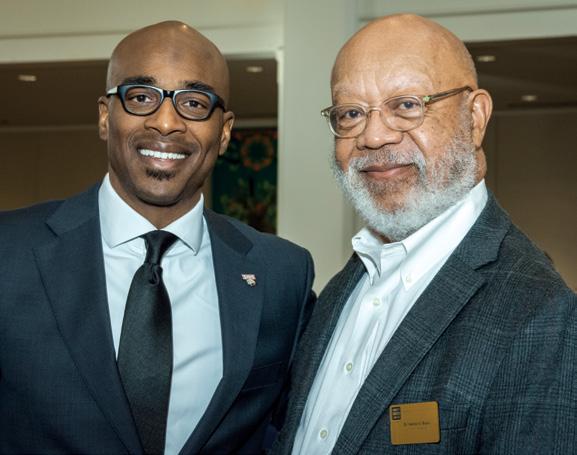
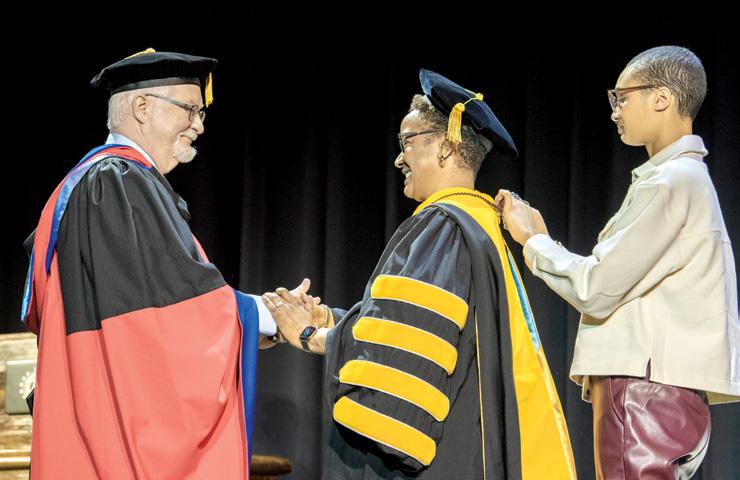
“ Welcome to our HMC family. We’re wishing you all the best as you lead us into the future.”
–DAVID ’80, P’18 AND ANNE P’18 SONNER

“Dr. Nembhard is a nationally recognized leader in the field of industrial and operations engineering … she is a voice on the national level for transforming undergraduate STEM education.”
–JIM BEAN ’77, CHAIR, HARVEY MUDD BOARD OF TRUSTEES“As a new parent, I felt President Harriet’s clarity, sincerity and open-hearted warmth. Today, I saw her strength of purpose and understanding. I rejoice in her leadership and join in her commitment to Mudd’s future.”
–TINA COLE P’28
Wishing
you a long and fulfilling tenure at Mudd blessed with wisdom, courage, grace and joy. Be well, be happy, be amazing!
–PATRICIA WANG, STUDENT ACCOUNTS MANAGER
“ Welcome to your new Claremont home, Harvey Mudd College. Look forward to the bright new future your leadership will bring us.”
–GERALD R. VAN HECKE ’61, PROFESSOR EMERITUS, CHEMISTRY
“I know you’ll tirelessly pursue advancing and building the stellar legacy of Harvey Mudd College and am excitedly anticipating the accomplishments HMC will achieve under your leadership!”
–JEROME JACKSON ’76, BOARD MEMBER, AABOG“As the fourth presidential couple of Harvey Mudd College, we are delighted to welcome you to HMC as the sixth president. We envy you the experience of working with the amazing trustees, faculty, staff, alumni and, most importantly, students—all of whom we enjoyed to the fullest! We are confident that you will as well.”
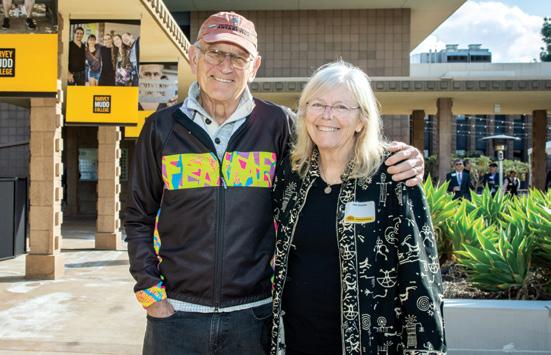
“I continue to be impressed with you as a scholar and a leader. I wish you the best in your new role as president of Harvey Mudd College. They will greatly benefit from your leadership. From one industrial engineer to another: keep up the great work!”
–LAURA ALBERT, DAVID H. GUSTAFSON DEPARTMENT CHAIR OF INDUSTRIAL AND SYSTEMS ENGINEERING, UNIVERSITY OF WISCONSIN-MADISONFind more comments on the Inauguration Guestbook hmc.edu/inauguration/guestbook
As part of Honoring Our Progress events during inauguration festivities, volunteers made science kits for local organizations and the young people they serve. Supported by the Alumni Association Board of Governors and student club Mudders Making a Difference, the event yielded 200 slime-making kits and 200 airplane kits (propelling innovation!), each containing handwritten, inspirational notes. Organizations receiving the kits include Upland Elementary School, Pomona Unified School District, Foothill Family Shelter and Serenity Homes, a tiny home community serving families experiencing homelessness.

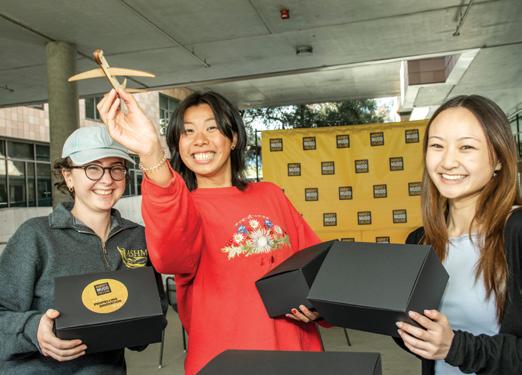



harriet b. nembhard’s inauguration as the sixth president of Harvey Mudd College provided an opportunity for higher education leaders to weigh in on the state of science education and the role of higher learning more broadly. At a Feb. 29 dinner, Nembhard posed talking points to a trio of academic peers who were in Claremont to celebrate her investiture: Gilda Barbarino, president of Olin College of Engineering in Needham, Massachusetts; Montserrat Fuentes, president of St. Edwards University in Austin, Texas; and Hiram Chodosh, president of Claremont McKenna College.
Their 40-minute conversation emphasized the importance of nurturing community and making science education malleable enough to meet the needs of students and society in the 21st century.
“One of the cornerstones of my presidency is around building a healthy community,” Nembhard said. “We’ve talked quite a bit about how we have to model that. We want to produce students who are good at STEM and good at life, and that has so many dimensions to it.”
Educating students who understand the impact of their work on society.
GB: In 1997 … the National Science Foundation and others spoke about the need for engineering education to be more hands-on, more project-based, [and for it to] speak more to real-world problems and how to solve them, to look at liberal arts and how it might be integrated with engineering. So, if you really wanted to affect that kind of change … they looked to Harvey Mudd. [At Olin], this crosspollination with Harvey Mudd—looking to one another for models and sharing—has been going on for quite some time. I can assure you that it’s going to increase with Harriet and me.
MF: We’ve tried to make sure that it is more than just passing knowledge in the classroom; we have a commitment to creating knowledge, then to put the knowledge into practice … All the different disciplines are exposed to research, innovation and creativity as part of the learning and training. [To] make sure all students have the access and the opportunity to benefit from everything Austin has to offer, we have integrated [internships and other community engagement opportunities] as part of the curriculum.
HC: When we started to think about reimagining science education for [CMC], we built in that sensibility of trying to integrate from the ground up disciplines that tend not to go together. The idea was to organize the department, not around disciplines, but around a grand challenge. So human health, with a focus on genomics; the brain with a focus on psychological disease and decision sciences;

Gilda Barabino is president of Olin College of Engineering. Barabino and Nembhard met through Richard Miller, a former dean of engineering at University of Iowa. Barabino and Nembhard collaborated on an article about a systems engineering approach to equitable health care solutions and continue to exchange ideas about creating synergies in this space.
and our planet with a focus on climate, energy and environment. We also wanted to have a problem-oriented approach … to engage students in this integrated way so they could put learning to work right away. Our mission in integrated sciences is to prepare young leaders … to take on the major challenges of undergraduate science education today and see if we can push forward by example a model where we have just-in-time learning rather than just-in-case learning.
GB: One of the things that I think Olin has done well is finding ways for people to share stories, including via Story Slams. Faculty members, staff and students are coming together as a community and sharing stories. The more opportunities there are for that, I think it makes a difference because we all want to feel like we belong, feel like we’re heard, and that our contributions are valued and respected.
MF: When we talk about communities, building relationships and having a set of shared values and a shared vision, it has to start by being able to meet each member of the community where they are, so they feel accepted. It helps to create a sense of belonging. It’s part of … preparing our students to be responsible citizens of the world. It starts with a safe community where everybody is valued, appreciated and heard.
HC: We need to bring a sense of fun to what we do, and we need to model that— that work can be really fun. We need to invest in our friendships with a sense of fun, because we need to take on these major forces that are

Hiram Chodosh is president of Claremont McKenna College. Chodosh and Nembhard were introduced through her friend, and in 2016 he brought Nembhard into CMC’s discussions concerning integrated sciences. These conversations have resulted in the Kravis Department of Integrated Sciences and The Robert Day Sciences Center building, now under construction.
causing tremendous sadness and loneliness in our student populations and take them on in the most rigorous and serious and imaginative ways.
Encouraging students and cultivating confidence and courage
HC: I’m a big believer in learning through experience … you have to give people experiences … We also need to create environments where [students] get out into the world and actually confront the things they’re trying to deal with … So, early internships, experiences on campus, anything that gives them something outside the classroom that is theirs so they get a feedback response that grows their own little classroom in their own gray matter.
GB: [As part of] of learning through experience, [students] need to have a problem where they deal with something big, like inequities that exist in the world. When you have to deal with lower-resource environments or lower-resource settings as part of your problem, you might have to be a bit more creative, and maybe a bit more courageous. And maybe when you get to the end of your solution, you might feel a little bit better about yourself … If we involve those we’re trying to serve in the design process, in being part of the solution, [we] might come up with a better solution.
MF: It’s also important that … [students] have the support—a community of individuals that truly believes in them and wants to see them be successful.

Montserrat Fuentes is president of St. Edwards University. She and President Nembhard first met while Fuentes was provost at University of Iowa and searching for a new dean of engineering there. Her academic background is in statistics which has intersections with Nembhard’s background in industrial engineering. The two worked together on an NSF-funded project that examined the matriculation of students and their well-being during the COVID-19 global pandemic.
Ho Nam ’88 and President Harriet Nembhard discuss the role of kindness and curiosity in venture capital
at the impressionable age of nine years old, Ho Nam came to the United States with his parents and two younger brothers. They left established and comfortable lives in Korea to begin life over again, and Nam credits his responsibilities and experiences growing up with helping him to forge a different, unique path. In addition to his work as a venture capitalist (he’s managing director and co-founder of Altos Ventures, a global venture capital firm), Nam is a champion for work being a spiritual journey that includes kindness and patience. On the blog Venture Differently, Nam writes about the importance of curiosity, service and work ethic in building successful companies and being an effective investor.
In a conversation with President Harriet Nembhard on Feb. 29, Nam spoke about his formative years (including Harvey Mudd), his career path, his thoughts on leadership and his appreciation for the humanities, social sciences and the arts.
How did you come to select engineering as your major?
I did gravitate toward engineering because at some point in high school, I read that the No. 1 major of all the Fortune 500 CEOs at the time was engineering. I went to this summer program at Darden Business School at University of Virginia, so I was interested in business, but then I read about engineering. And I thought, well, it teaches you fundamental problem-solving skills, analytical skills, and I thought it would teach a really interesting skill set to enter the business world.
I had some exposure to MIT because I went to school in the Boston area. I actually didn’t know anything about Harvey Mudd. But when I found out about Harvey Mudd [through] “Junk Mail” [admission recruitment piece]—the statistics and other kinds of grad schools that people were accepted to, the average SAT scores, the kind of careers people went on to—I was very intrigued. But the thing that really made Harvey Mudd stand out is you had to take a third of all your classes in the humanities, and you had to minor in the humanities; I thought that was really interesting. I ended up taking so many classes outside of the core STEM work that I made up my own minor: politics, philosophy and economics.
In 1988, you received the Radley Prize awarded by the Department of Humanities, Social Sciences, and the Arts. How did you see it then and how do you see it now?
It was very gratifying in some ways because this is the reason I picked this College. This is why I was fascinated, and I was inspired by the mission. Harvey Mudd was founded in the ’50s, in the middle of the nuclear and the space age, and it was so critical for scientists and engineers to understand the potential negative impact as well as the positive impact on society. And that’s what really the founding principles of Harvey Mudd were all about. That inspired me, that’s what got me to come to school here in the first place. And to think that at graduation I got associated with this mission of the school, and that was quite special.
You can’t accomplish anything unless you work with other humans, inspire them and are committed to a common mission. The more I work in the real world, the more I realize this

training that you have in humanities, philosophy, politics, economics, all of these things that I’ve studied at Harvey Mudd, how critical that is. And then, of course, we’ve had role models like Steve Jobs who was famous for saying that really interesting things happen at the intersection of the sciences and the humanities. It’s all about the intersection of the two, and Harvey Mudd represents that more than any other educational institution I know of.
Can you tell us about Altos Ventures and what the ethos of “venture differently” means? I started Altos Ventures with two classmates from Stanford Business School. A Stanford professor had been advising an investor, and he no longer had the bandwidth to continue to advise. [He asked the investor] why don’t you just hire some young people to help manage this pool of capital?
So, we did not have to fundraise for our first funding in 1996. We were just kind of asked, and they had to convince us to consider doing it. Our recommendation to the investor was: Don’t do it. Let’s just stay in touch because when the markets crash, that would be a good time to start. They convinced us to get started anyway, in a small way, kind of learn by doing, and if the markets ever crashed, they would have a lot of capital to put to work, and then we would have a running start.
What happened was that we did eventually run into the crash in the dot com era, and we were incredibly humbled. We thought we were so good; we were doing so well. When the markets are going up, you think you’re so smart. It was really during that period that we understood what “venture differently” was all about. We had to do a lot of soul searching … It made us fundamentally question all of our assumptions.
It was around that time that I went to the first annual meeting at Berkshire Hathaway in Omaha. It was May of 1999, peak of the bubble. Of course, everybody’s asking Warren Buffett, how come you’re not investing in telecom and these dot coms; you’re missing it! He very calmly explained what he was doing and why he was
going to stick to his knitting. I thought that was really fascinating. It was at the height of our arrogance, yet I sensed something was different. He talked for decades about how he was better off in Omaha; he was glad he was not in New York City with all the other investors, because all that noise, all that chatter, all that groupthink would have crowded his mind. So, he is the exemplar for think different, do things your own way, separate yourself from the crowd. And that really got us on the journey of how do we reinvent the venture capital model? How do we do things differently?
Things kept getting worse. [The year] 2000 is when the crash started. In 2001, September 11 happened, things kept getting worse, and it really bottomed out in 2003. We didn’t raise our first fund after the dot com crash until 2005. These days we raise a fund every couple of years; there was a six-year gap between our ’99 fund and 2005. We were able to somehow survive that deep, low, dark period. East Coast University Endowment backed us—they were the anchor LPs, a very established limited partner in some really famous venture funds—because we had a different thesis about how to make money in venture capital, and it was an alternate thesis to the mainstream. They continued to invest in the mainstream venture capital, but, they said, we have room in our portfolio for something like this—something different.
To me, it was a clear lesson in life that you could strive to be better or strive to be the best, but also you could strive to be different. The differentiation—something that’s uniquely authentic to who you are, and a unique voice in the world—that has a chance to be heard. Fast forward since 2005 to now, Altos has become the second-most important relationship they have across all of the managers across all asset classes, passing some of those other established firms that they’ve been involved with since the 1970s. But we did it in less than half the time with less than half the capital that they have committed over the years. So, we had to be different to just survive.
About Ho Nam
Ho Nam is a managing director and co-founder of Altos Ventures, a global venture capital firm and registered investment advisor with more than $8 billion in regulatory assets under management. Before starting Altos in 1996, Nam worked at Silicon Graphics. He began his VC career at Trinity Ventures and his professional career at Bain & Company. Nam received an MBA from Stanford University and a B.S. (engineering) from Harvey Mudd College. During his time at Harvey Mudd, he was awarded the William and Margaret Radley Prize in Humanities, Social Sciences, and the Arts. The prize is awarded annually to a Harvey Mudd senior whose work in the HSA program best exemplifies the College’s goal that all students should gain an understanding of themselves and their fellow human beings as well as of the physical world around them.
This talk, held during inauguration festivities, was funded by the Annenberg Program Endowment for Leadership, an integral part of Harvey Mudd College’s commitment to encouraging students to lead with integrity. The speaker series brings to campus accomplished individuals who are recognized, world-class leaders in their fields of endeavor.
View the full talk on the College’s YouTube channel under Annenberg Speaker Series.
The Alumni Association recognizes important contributions of members of the Harvey Mudd community through its awards program.
Nominations for the Spotlight Recognition Award and other awards are welcome and are reviewed by the Selections Committee of the Alumni Association Board of Governors. Submit a nomination at bit.ly/HMCalumawardnom.

With a kind heart and thoughtful planning, you can nurture future generations of problem solvers and develop a legacy. It begins with a few simple words added to your will, trust, retirement account or life insurance policy. Let us show you how.
To learn more, contact Stephen Tanenbaum, director of planned giving, at 909.243.9969 or sttanenbaum@hmc.edu.





Over 300 parents and family members attended Family Weekend, Feb 2–3, to take part in information sessions, campus tours, Senior Parent Toast and a student/parent competition: building and racing balloon cars.
View more Family Weekend images from HMC Flickr at bit.ly/FWPhotos-2024
View the Family Weekend video on the College's YouTube channel.



 Parent Leadership Council members Andrew Parker P’26 and Wen-Chia Parker P’26 show off their bee-inspired balloon car with daughters Lanikai and Makena.
John Woodside ’24 and sister, Katie, with President Harriet Nembhard.
Charity Rock P’27 and Abraham Rock ’27
Parent Leadership Council members Andrew Parker P’26 and Wen-Chia Parker P’26 show off their bee-inspired balloon car with daughters Lanikai and Makena.
John Woodside ’24 and sister, Katie, with President Harriet Nembhard.
Charity Rock P’27 and Abraham Rock ’27

Bill (engineering) and Karen Hartman ’77 (math) visited the jail cell of Dr. Samuel Mudd in Dry Tortugas National Park. Mudd was a doctor from Southern Maryland who set John Wilkes Booth’s leg the morning after Abraham Lincoln’s assassination. The park is about 70 miles west of Key West, accessible only by boat or seaplane.

Robert Beck (math) is professor emeritus at Villanova University, where he taught for 55 years. “Looking over my old grade books, I count 53 different courses that I taught, from several flavors of calculus to operations research to organization of programming languages to human computer interaction and many subjects in between. In my retirement, I continue to hold office hours for my nine grandchildren, though the oldest is now doing a PhD in mathematics in an area—graph signal processing—beyond my current understanding. My wife, Barbara, and I have taken all but one of the grandchildren on a 13th birthday trip somewhere in the U.S. We get to choose the destinations, which have included a number of western national parks. And in our spare time, we're trying to make a difference in our small corner of the world.”

Hal Bohner (engineering) has had some major changes in his career path since leaving HMC. He’s now a professional artist and participated in an open studios exhibition called “Art at the Source” in Sonoma County in the San Francisco Bay area. Bohner’s paintings are posted on his website, halbohnerart.com.

George Conner (physics) was recently in Fiji cruising on his sailboat (a Norseman 447) and visiting the Eastern Islands. He said, “Sailboats present all kinds of challenges where a bit of physics knowledge comes in handy.”
Mark Mrohs (physics) received the American Solar Energy Society’s Claudia Hansen Wentworth Award for Code Development, Innovation and Training. Mark has been involved in solar (photovoltaics or PV) since graduating from Mudd. He worked in the R&D department of Spectrolab during the summer of his junior year, making high-efficiency solar cells for spacecraft. That launched a lifelong career in solar. Since then, he has worked for Spectrolab, ARCO Solar, Siemens Solar, Astropower, GE Solar, Sunpower, Echo Solar and SunEdison. Mark now works with Interplay Learning, where he develops 3D and VR simulation training for solar technicians.

For a few decades now, Brian Rohrback (chemistry) says he’s been a pusher for chemometrics, the application of multivariate statistics in chemistry. “I try to distinguish between vision and hallucination as scientists and engineers attempt to travel down what is now referred to as the AI/machine learning road. It is interesting to examine the interplay of the fields involved in data interpretation and how sometimes a name change gets perceived as a brand-new field of endeavor. It has been fun to solve problems as diverse as clinical diagnostics, QC of gasoline, identifying food fraud or unmixing complex pollution sources, and then building an automated analytical chemistry system to do the routine analysis.”
Andrew Lees (chemistry), a 2015 Outstanding Alumnus, has received The Derek Horton Award in Industrial Carbohydrate Chemistry from the CARB division of the American Chemical Society, who acknowledge distinguished achievements in and outstanding contributions to industrial carbohydrate chemistry. Andrew’s award is for his contributions to the field of protein polysaccharide conjugate vaccines, including the development of CDAP chemistry and a low-cost CRM197 carrier protein. Andrew is the founder and CEO of Fina Biosolutions, LLC, a company focused on promoting affordable conjugate vaccines, a class which includes vaccines for S. pneumoniae and meningococcal disease. Among his contributions to the field, he developed CDAP chemistry for activating carbohydrate hydroxyls, allowing for the efficient linking of proteins to polysaccharides.

Sammy Yoshida (engineering) worked for three great companies during his career: Procter & Gamble, Clorox and Nestle. He did engineering for their manufacturing locations—renovations, expansions, upgrades, several green field sites—and retired in July 2020. He and his wife, Sheila, are enjoying eight grandchildren as well as golfing and fishing.

On an episode of Casual Space, John Mankins (physics), author of the book The Case for Space Solar Power and a 25-year employee of NASA, described how space solar power is feasible and affordable. John is president of Artemis
Innovation Management Solutions LLC and is an internationally recognized leader in space systems and technology innovation. While at NASA, John was the manager of Exploration Systems Research and Technology within the Exploration Systems Mission Directorate with responsibility for an $800 million annual budget, involving more than 100 individual projects and over 3,000 personnel. For 10 years, he was manager of Advanced Concepts Studies at NASA and the lead for critical studies of space solar power, highly reusable space transportation, affordable human exploration approaches and other topics. He was the creator or co-creator of numerous novel concepts, including the MagLifter electromagnetic launch assist system, the Internet-based NASA Virtual Research Center the Solar Clipper interplanetary transport vehicle, the SunTower space solar power system, the Hybrid Propellant Module for in-space refueling, the HabBot mobile planetary outpost architecture, and the Advanced Technology Lifecycle Analysis System. He is the first recipient of the prestigious NASA Exceptional Technology Achievement Medal.
Brian Hammond (chemistry) recently landed his dream job: director of scientific computing systems at the Albert Einstein College of Medicine. He writes, “After years of sales jobs to the scientific community, I get to work directly with researchers to achieve their goals. And I get to work for Albert Einstein.”
Dean H. Motoyama (engineering) has been recognized by Marquis Who's Who. With a career spanning four decades, Dean is a seasoned professional known for his expertise in technology and renewable energy. As the president of Diamond Head Technologies Inc. in Honolulu since 2017, he has been instrumental in managing projects that push the boundaries of innovation. He’s held roles at World Wide Technology, Cisco Systems (where his interest in renewable energy deepened), 3Com and GTE Hawaiian Tel. He has two patents—one received in the U.S. and the other in Taiwan—that reflect his dedication to addressing critical issues in the energy sector and serving to mitigate waste power generated by photovoltaic systems on the grid, which can lead to brownouts or blackouts and damage
transmission systems. Dean’s goal is to establish international power sites that promote recycling and environmental preservation.

Alvarez
received the 2024 Community College Award from the American Association of Hispanics in Higher Education. He said, “I share this recognition with the many students whose lives have been transformed by the learning culture, especially my MESA stars from San Diego City College!” The award “recognizes an individual who has demonstrated excellence in advocacy, teaching, or leadership and has provided significant contributions to the community college enterprise.” Rafael is director of San Diego City College’s Mathematics, Engineering, Science Achievement (MESA) Program, which he founded in 2000.
Amanda Minieri (engineering) writes, “I completed an engineering career of approximately 24 years of software engineering in 2019, when I finally got a master of science in computer science (SDSU). Now I’m happily retired.”
Scott Chesney (physics) is living with his husband, Chris, and 14-years-old twins, Ben and Emmy, in Madison, New Jersey. Scott says, “We’re excited to be celebrating middle school graduation and to be moving into the rebuilt family summer house in Michigan after a three-year project. We’re always happy to welcome old friends who make it to New York/ New Jersey or Western Michigan.”
Jeff Hong (IPS) shared his story—“LGBTQ+ Technology—A Civil Rights Journey from the Mudd Joker”— for the spring Mudd Talks series. Jeff is the founder and chief technology officer of Techmana LLC, a Hawaii-based software development and cybersecurity company. Prior to Techmana, he founded Micro-
soft’s Hawaii office and served as a major in the Hawaii Army National Guard, as a military intelligence officer and computer emergency response team chief. He is the board chair of HawaiianEthos, one of eight medical cannabis licensees and was recently appointed vice chair of the Honolulu Liquor Commission. He is active in the civil rights community as a longstanding board member of the ACLU of Hawaii and served in various roles, including national board affiliate representative, vice president and nominating committee chair. He was the first person from Hawaii elected to serve as an at-large ACLU national board member. He is chair of the Change 23 Coalition that seeks to repeal and replace discrimination from Hawaii’s constitution.
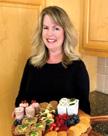
Susan Doherty (engineering) has been a chief a marketing officer in various Silicon Valley tech companies for many years. She’s working as an executive coach with the mobile games team at Electronic Arts. In her free time, she’s written two cookbooks.
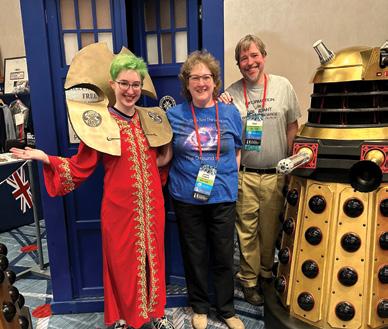
Jenny Booth Ellsworth (physics) married Scott Ellsworth ’89 (math) and stayed in California. She taught electronics and computer skills and did IT work for a long time before spending the last 18 years as a stay-at-home parent and science mommy and school district volunteer (libraries, computer labs, art, science fairs). The Ellsworths are the proud parents of a current Mudder (Class of 2026).

Alan Peltier (engineering) left aerospace in 1999 to join HRE Performance Wheels as the lead engineer. He writes, “Being a car guy, it was a dream job for me. I got to be around exotic cars and work for a small company where I could really make a difference. Twenty-four years later, as president/CEO, I spend a lot less time designing wheels than I do protecting our strong culture, but I am still involved in wheel design and absolutely love my job. I live in Carlsbad, California, with my wife, Anne SCR ’94, and we have two wonderful teenage children. I recently got my pilot’s license and deeply regret not going through the Bates Program at Mudd. I’m now working on getting my IFR rating, which is genuinely hard. Since I like creating things, I recently started building an airplane in my garage, which I expect to take about two years to complete.”
Tish Birge (engineering) is chief operating officer of the San Diego County Water Authority where she oversees day-to-day operations and supports the general manager’s strategic initiatives. Tish joined the Water Authority in 2021, following four years as general manager of the Sweetwater Authority. Previously, she served as Rincon del Diablo Municipal Water District’s director of administration and finance and as assistant general manager for San Elijo Joint Powers Authority. She is a Certified Special District Manager and Registered Professional Engineer.

Harr (engineering) took on a new role with Evergreen Consulting Group as electric vehicle program manager. He partners with utilities to support EV conversion in commercial fleets and charging infrastructure development in rural markets. He continues to partner with affordable housing partners on his unpaid side hustle Solar for All Inc. “We’ve installed solar on
over 30 affordable homes in Oregon and Washington in the last 10 years, saving homeowners over $60,000 on utility bills and avoiding over 100 tons of CO2. We have another 15 homes in progress in 2023–2024.”
Apollomics Inc., a clinical-stage biopharmaceutical company developing medicines to address difficult-to-treat cancers, appointed Matthew Plunkett (chemistry) chief financial officer. Matthew brings to Apollomics over 25 years of diverse strategic and financial experience within the biopharmaceutical sector. He’s held the chief financial officer position at Aeovian Pharmaceuticals, Imago Biosciences (where he led the efforts for the company’s $155 million Nasdaq initial public offering) and Nkarta Therapeutics (where he led the efforts for its $290 million Nasdaq IPO). He was chief business officer at CTI BioPharma, a commercial stage hematology-oncology biopharmaceutical company, and held a variety of positions at CIBC World Markets and its U.S. successor Oppenheimer & Co., including managing director, head of West Coast biotechnology.
Joe Beda (CS) writes, “I’m (maybe?) retired! While at Google I co-founded an open-source project called Kubernetes. It has been a wild ride since then! I left Google, took some time off, started a company (Heptio), sold that company to VMWare and, just recently, left VMWare. I’m currently spending time with the family (two daughters, 17 and 14) and looking forward to investing in hobbies and traveling. I'm not sure what comes next, honestly!”
PrePass, North America’s leading commercial motor vehicle weigh station bypass and toll and violation management service, appointed Chas Wurster (CS) as chief technology officer. Most recently, Chas served as CTO at Platform Science, a leading telematics and IoT service company. He will leverage his over two decades of entrepreneurship and technical leadership to shape the future of PrePass’ product and technology strategy.
Elise Lawson (biology) is an associate professor of surgery at the University of Wisconsin School of Medicine and Public Health specializing in colorectal surgery. She is also the executive director of the Surgical Collaborative of Wisconsin.
Gregory Rae (CS/math) and Carl D. White, co-owners of Martian Entertainment, a Tony award-winning theatrical general management and production company, are co-producers, with Thomas E. Rodgers Jr., Renee Rodgers, Vanessa Williams and Elizabeth Curtis, of A Wonderful World: The Louis Armstrong Musical on Broadway. Set to debut in fall 2024, the play features Tony Award winner James Monroe Iglehart (Disney’s Aladdin, Hamilton, Spamalot), who will star as jazz legend and American icon Louis Armstrong. Gregory is a 2015 HMC Outstanding Alumnus.
Greg Alexander (biology) writes, “Despite being a biology major, I’m working with an engineering firm. We design electrical and mechanical infrastructure projects. On the side, I'm developing an air emission capture and treatment system for ocean going vessels.”
After 13 years at Google, Titus Winters (computer science) accepted a position as senior principal scientist at Adobe. He says, “I’m primarily focused on developer experience: education, best practices, tooling, etc., to improve engineering efficiency. I’ve also recently completed the three-year ACM/IEEE/ AAAI CS2023 project, defining curriculum requirements for CS programs. I still live in NYC with my wife, Victoria.”

Eric Harley (math) writes, “After successfully bringing AI to the USDA meat police, I bit the bullet and decided to leave the government R&D sector for the Big Tech scene. Last summer, I started a new job at Microsoft Security in threat defense engineering where I am again leveraging mountains of data, high-performance computing, machine learning and my Mudd math education to combat sophisticated cyber threats. This did require a bit of an attitude adjustment going from HBO’s Veep to HBO’s Silicon Valley, but I’m managing. In January 2023, I popped up to Boston to crash the department’s reception at the Joint Meetings and snagged a photo with Caitlin Lienkaemper ’17.”
Paula Diehr ’63, P’90 is celebrated for her many contributions
pioneering biostatistician paula h. Diehr ’63, P90 has developed statistical methods and approaches used by thousands of health services researchers. She has used her mathematics and statistics training to design innovative methods and longitudinal analyses using large datasets to draw out meaningful information and conclusions about medical diagnoses, healthcare interventions, understanding mental health services, and large health insurance reimbursement systems.
The ARCS Foundation Inc., a nonprofit, volunteer women’s organization that provides scholarships to students majoring in the STEM and health disciplines, named Diehr the 2024 inductee into the ARCS Alumni Hall of Fame. It is an honor that brings her career journey full circle.
Through a Los Angeles Chapter ARCS Scholar Award in 1960 and 1961, Diehr was able to attend Harvey Mudd College. It was one of the chapter’s first awards to the College and its first to a woman. “The support from the ARCS Foundation was the basis of my entire career,” Diehr says. “Coming from a modest background, I could not have afforded my undergraduate education without this help. At a time when there were not many female scientists, the support from groups such as ARCS for a female scientist was particularly gratifying.”
Hall of Fame inductees are ARCS Scholar Alumni who have made outstanding contributions to the advancement of science in innovation, discovery, economic impact, the development of future scientists and the enhancement of the United States’ scientific competitiveness. Diehr, a 2013 HMC Outstanding Alumna, is professor emeritus in biostatistics joint with health (now known as Health Systems and Population Health) at the University of Washington School of Public Health, where she spent her entire career. She is the author of more than 200 scientific papers and a fellow of the American Statistical Association, the Association for
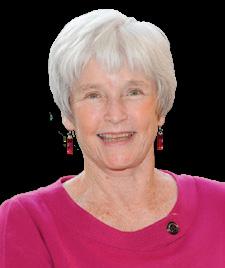
With son, Michael Diehr ’90, Paula Diehr ’63 developed a Healthy Life Calculator that allows seniors to estimate the number of “good” years they have remaining.
Health Services Research and the American Association for the Advancement of Science. Her work directly impacted methods for assessing healthy weight standards for older adults and diagnostic rules for maladies, such as headaches and pneumonia. Globally, her analytical tools helped other researchers use large datasets to study healthcare interventions and their economic impact.
With son, Michael Diehr ’90, she developed a Healthy Life Calculator (healthylifecalculator. org) that allows seniors to estimate the number of “good” years they have remaining. Unlike other web calculators, this one estimates how long a person will be healthy and active, gives ranges of likely values and is documented in a peer-reviewed publication.
“In this 65th anniversary year of ARCS Foundation, it is especially meaningful that Dr. Diehr, the first woman scholar to receive an ARCS Scholar Award from our Los Angeles Founding Chapter, is our honored Hall of Fame Inductee,” said Beth Wainwright, national president of ARCS. Since 1960, the Los Angeles Chapter has granted to Harvey Mudd $4.3 million for 715 ARCS Scholar Awards given to 405 ARCS Scholars. “As a pioneering biostatistician and leader in the field of health services research, Dr. Diehr is a welcome addition to the distinguished ARCS Alumni Hall of Fame.”

Ruben Arenas (math), formerly the VP of instruction at East Los Angeles College, recently took a leave from the college to pursue life abroad with his 16-year-old son, Carlos. They have been residing in Bangkok, Thailand, since August 2022, attending school and enjoying the culture. Carlos is completing his high school education at an international school, while Ruben is learning Thai at a local language school. Ruben has since accepted a software engineering position with Edge Tradeworks, where he works remotely with one of his former students, to expand its loan trading platform. In addition, Carlos has discovered a passion for acting and recently landed a lead role in his school’s production of Our House During their stay in Bangkok, Ruben met his partner Nontawat (“Ballon”). Together, the family enjoys hitting the gym, board game cafes, karaoke (in multiple languages), concerts and exploring the city’s various restaurants, malls and night markets. They frequently host family and friends and love to travel, with short trips to Chiang Mai and Issan for the Songkran holiday. Carlos embarked on his first European trip this summer with Mudder Mjumbe Poe ’05

Karen Hsin Wnuk (engineering) released Pacific Drive, a supernatural driving game on PC and PlayStation 5 described as “Stephen King’s X-Files in a station wagon.” She was the game’s lead narrative designer and lead writer, creating a sci-fi world where the perils of science gone wrong is on full display. The
main character is an embittered scientist named Ophelia Turner, whose experiences in the ’60s—as a woman navigating scientific research while watching horrors unleashed upon the world because of her invention— lead to a lifetime of regret.

Tracy Fox (engineering) is senior VP of technology at Columbia Distributing, a beverage distributor in Washington and Oregon. She runs an IT department of about 40 teammates responsible for business applications, data and reporting, networking, infrastructure and service desk. Tracy lives in Ridgefield, Washington with two kids, Lily and Liam, two cats and two dogs. She volunteers as a mentor for Minds Matter Portland for underrepresented high schoolers striving to get into four-year colleges. In her free time, she completed a corporate finance certification through UCLA.
Jenni Rinker (engineering) finished her PhD in mechanical engineering from Duke University in 2016 and has since been working at the Technical University of Denmark’s Wind Energy Department. She started as a post-doc/ researcher and is now an associate professor, teaching in aeroelasticity and introduction to Python programming.

Eric Nacsa (chemistry), assistant professor of chemistry at Penn State, has been honored with a Faculty Early Career Development (CAREER) award from the National Science Foundation. The CAREER award is the NSF’s most prestigious award in support of early career faculty members who can serve as academic role models in research and education and lead advances in the mission of their department or organization. The CAREER award will provide five years of funding to support Eric’s research studying the development of new chemical catalysts powered by electricity to promote dehydration reactions. These reactions are critical in the creation of commonly used organic compounds, such as medicines, materials, food additives and perfumes. However, they invariably produce substantial amounts of additional chemical waste. Dehydration reactions
that avoid this waste would improve the ability to discover and manufacture medicines.
“The research community appreciates that catalytic dehydration methods would avoid this waste problem because catalysts promote reactions without being converted into waste, but technical challenges have prevented the development of such methods,” Eric explained. To address this problem, the Nacsa group designed a system wherein a simple sulfur-containing catalyst promotes dehydration reactions when electricity is passed through a reaction mixture. The NSF funding will allow the group to significantly expand this platform and use it to make higher-value products. The funding will also support an in-depth study of an emerging classroom-assessment technique called “specifications grading” in large-enrollment organic chemistry courses.
Eric was previously granted a Doctoral New Investigator Award from the American Chemical Society Petroleum Research Fund in 2022. Prior to joining the faculty at Penn State in 2019, Eric was a National Institutes of Health postdoctoral fellow at Princeton University. His postdoctoral advisor, David MacMillan, won the 2021 Nobel Prize in Chemistry.

Haley Ham (biology) has been working at Counsyl, a genetic testing company located in South San Francisco, as a clinical lab scientist for almost 10 years. She writes, “We were bought out by Myriad Genetics few years ago, and I continued to work for the company until May 2022. Then, I decided to take some time off from working to raise two sons at home, and it’s been exhausting, but I’ve also experienced so much love and joy with these two babies. My first son is 2 and the second son is 5 months old. (Picture shows the youngest at 100 days old.) I thank HMC’s rigorous education for preparing me well for not only a good career, but also for
parenting! I miss the challenges I had on campus and such supportive faculty members during the process. Hope I can visit the campus one day with my sons.”
Simeon Koh (biology) finished medical training (fellowship in palliative care and hospice) and started work as a palliative care physician at PIH Whittier Hospital.

Brianna Posadas (engineering) is an assistant professor in the School of Plant and Environmental Sciences at Virginia Tech. Her research is focused on the intersection of agriculture, technology and user-centered design. When she completed her PhD at the University of Florida, she was the first Latina to earn a doctorate from the Department of Computer and Information Science and Engineering. Brianna lives in Blacksburg, Virginia, with her husband, Ryosuke Yokosawa, whom she met during a project with HMC’s Global Clinic Program with Kogakuin University.
David Derry (engineering) leads two teams at Raytheon on R&D projects for radar signal processing.
Aaron Rosenthal (physics) recently defended his physics thesis for the MIT PhD program on plasma transport in tokamaks. In May 2023, he started a new job at Commonwealth Fusion Systems designing spectroscopy diagnostics for their net energy tokamak device, SPARC, which is targeting first operation in 2025.
In summer 2022, Jennifer (Rogers) Brennan (math) completed her PhD at the University of Washington (computer science and engineering), advised by Kevin Jamieson. Her thesis was “Experimental design with scientific applications.” In October 2022, she started at Google Research in the Market Algorithms NYC team (although she’s based in the Kirkland, Washington, office), working on the design of experiments in marketplaces.
correction (We apologize for errors in this entry in the 2023 fall/winter issue. The following is the corrected note.): Samantha “Sam” Hoang (engineering) completed a PhD in mechanical engineering at University of Washington in August 2022. She is in her first year as an assistant professor at Seattle University, where she looks forward to teaching engineering to and doing research with students. Samantha says, “I have also adopted a dog during my time in Seattle and have gotten into a variety of outdoor activities, including climbing and backpacking. I had the opportunity last summer to backpack the Enchantments after snagging a very rare permit.”

Sarah Wang (engineering) works at Joby Aviation, an electric vertical take-off and landing (eVTOL) startup based out of Santa Cruz, helping certify the next generation of aircraft. Her role as a designated engineering representative applicant is to ensure that the software written for this new mode of transportation is reliable and safe.
In October 2023, Sarah married Aaron Wang, who also works in aviation (Amazon Prime Air).
Zoe Ryan (CS) is a solutions architect at NVIDIA, working with higher education institutions and researchers to utilize GPUs in their high-performance computing and simulation applications. She writes that her job is a great mix of in-depth technical work and engaging with customers moving the needle of graphics processing unit technology.
The Makati Finance Corporation board elected Carmen Therese L. Benitez (CS/math) as director. Carmen works as a forward deployed software engineer at Palantir Technologies in New York City. Prior to Palantir, she was a software engineering intern at Bloomberg LP, contributing to the accessibility of the Bloomberg terminal and as a Student Training in Engineering Program Intern at Google, where she developed web applications and optimized testing processes.
Have you changed jobs? Retired? Celebrated a milestone?
In addition to updates you submit, we compile information from a variety of sources: campus event notices, newspaper and magazine articles, press releases and Google alerts. Please submit updates to alumni@hmc.edu
Robert C. Ashenfelter ’61 (physics)

The College received word that Bob died in December 2022. After Harvey Mudd, Bob attended Caltech, working in the lab where Graydon Bell had worked. In 1967, he graduated with a PhD in atomic physics then switched to electrical engineering and joined the technical staff of AT&T Bell Telephone Laboratories in New Jersey. He worked on digital test systems and designed millimeter-wave transmitter oscillators for a waveguide transmission system. He led firmware development for a system that used early microprocessors to switch voice circuits in a system and developed a time-sharing operating system that was deployed on undersea cable circuits. Other projects included circuit-board design for a project that used digital packets to integrate voice, data and video, for which he earned a patent. As part of Lucent Labs, Bob worked on submarine systems (undersea cables). After 30 years, he retired from AT&T as a distinguished member of the technical staff. Bob was a canoeing enthusiast, hiker and avid cyclist; he passed 100,000 miles, putting more miles on his bicycle than his car. In 1984, he rode solo across the U.S., 3,444 miles in 34 days. He also attended trips sponsored by the HMC Alumni Office, including to Kenya in 1987 with Prof. J. Arthur Campbell and to Russia in 1994 with Prof. Nathaniel Davis. He enjoyed living in New Jersey and taking care of his orchid plants, including one given to him in 1966 by his mother.
William Leppo ’61 (engineering)

Bill died March 26. Bill began his professional career at the Naval Ordnance Test Station in China Lake, California, as an electrical engineer. He went on to work for 10 engineering firms, including at Computer Automation Inc., where he designed and implemented a minicomputer. He started and ran Leppo Instruments, a hardware/ software/firmware design firm for 14 years. With wife, Brenda, he raised sheep and chickens, and, for many years, enjoyed riding motorcycles, thanks to Bill Hartman ’62, who introduced him to the hobby.
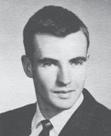
The College received word that Richard died in 2019. He spent a short time at HMC before transferring to CMC, where he earned a B.A. in business/ economics. For 37 years, he worked in human resources for Beckman Instruments in Orange County, California. He served in the U.S. Marine Corps and the Army National Guard, retiring as a colonel in 1994.
Don Pellinen ’61

The College received word that Don died in 2022. In the Founding Class yearbook, Don wrote “Being accepted to Harvey Mudd College and being given a full scholarship was the outstanding event in my life.” He fondly recalled the “ideal” environment and classes taught by Prof. Campbell (chemistry), Prof. James (calculus), Prof. Roller (mechanics) and Prof. Wickes (English). After two years, Don transferred to UC Berkeley, where he earned a B.A. in physics before taking a job with Space Sciences Lab at University of California, where he designed radiation detector packages for a lunar lander and the first geostationary satellite. He flew four satellites on the Interplanetary Monitoring Probe series of satellites. He attended grad school and worked at Physics International Corp. He worked on several experimental programs, including one to do the beam transport experiments for a PBFA fusion system at Sandia Labs. In 1980, he changed professions and worked in the integrated circuit industry. Don was married to Maria Elena Chávez Moran, a retired philosophy, Spanish and humanities teacher. They are parents to three daughters and a son and are grandparents.
Ron Smith ’61

The College received word that Ron had died. Ron enlisted in the U.S. Air Force in 1951 and served in the Korean War before enrolling in Imperial Valley Junior College, where he learned about Harvey Mudd College. He was an atypical member of the Founding Class about
six years older than everyone else and married. Due to financial reasons, Ron left HMC in 1959 and began working as a “journeyman” engineer at General Dynamics in Pomona while attending Cal Poly Pomona, where he earned his bachelor’s degree in electrical engineering. He and his wife, Mitzi, built a family of five boys and one girl. In 1988, Ron remarried and his second wife, Sandy, added her four daughters and one son to the mix, resulting in 14 grandchildren and several great grandchildren. After a 35-year career with General Dynamics, Ron retired shortly after the Missile Division was purchased by Hughes Aircraft in 1992. Ron worked for several years at JPL in the facilities group at Caltech then “re-retired” in 1998. For many years, he enjoyed his computer and was an avid pencil sketching artist.
Rolly Wilbur ’61

The College received word that Rolly died several years ago. Known as the resident “hammer thrower,” Rolly spent two years at Harvey Mudd then completed his bachelor’s degree in Spanish in 1965 at UC Berkeley, where he connected with Mike McKinney, Bob Downs and Don Pellinen. While Rolly changed his academic major to Spanish, he said he owed his career to his two years of math and science at Harvey Mudd. In 1964, to round out what he was learning in the classroom he visited Spain, southern France, Italy, Switzerland, Germany and Denmark. In 1968, he began as a freeway designer for Caltrans’ district office in San Francisco. Rolly then transferred to on-site freeway construction projects in the East Bay. He continued to travel to Europe for vacations. In retirement, he spent eight months a year in Portugal after he fell in love with the country and its people. Every winter into early spring, Rolly returned to the U.S. to visit his sister in Los Angeles. On one of his visits in spring 2002, Rolly returned to Harvey Mudd for lunch and a campus tour with fellow Founding Class members Don Gross, Dave Howell and Jerry Van Hecke.

As we close a remarkable academic year, we’re grateful for Harvey Mudd’s annual fund supporters. The annual fund is a critical resource, supporting approximately 6% of the College’s annual operating budget. Gifts to the annual fund support the College’s critical needs, fostering growth and transformation beyond what tuition covers. Before Harvey Mudd’s fiscal year ends on June 30, please consider supporting the annual fund by making your donation. Your gift can nurture current and future Mudders and propel their journeys beyond the College.
Harvey Mudd’s talented students are supported by annual fund gifts, which provide essential financial aid and scholarships. By eliminating financial barriers, students can focus on academics, enjoy extracurricular programs and build lifelong connections in this amazing community.
Contributions to the annual fund foster an environment where students thrive, engage in groundbreaking research and experience transformative learning. The fund supports essential resources from classroom and laboratory technology to student success services empowering students and faculty to excel.
The annual fund enriches campus life and community engagement activities, including the Homework Hotline, spiritual life and wellness initiatives. The fund creates a vibrant and supportive community, nurturing well-rounded students who excel at STEM and are prepared to navigate life beyond Harvey Mudd.
Together, we can continue the College’s mission of excellence and innovation. As Harvey Mudd’s fiscal year closes June 30, we invite you to make a gift to support current and future Mudders.
To give before June 30, scan the code below and return your gift in the envelope provided in this issue, or visit hmc.edu/give
hmc.edu/magazine
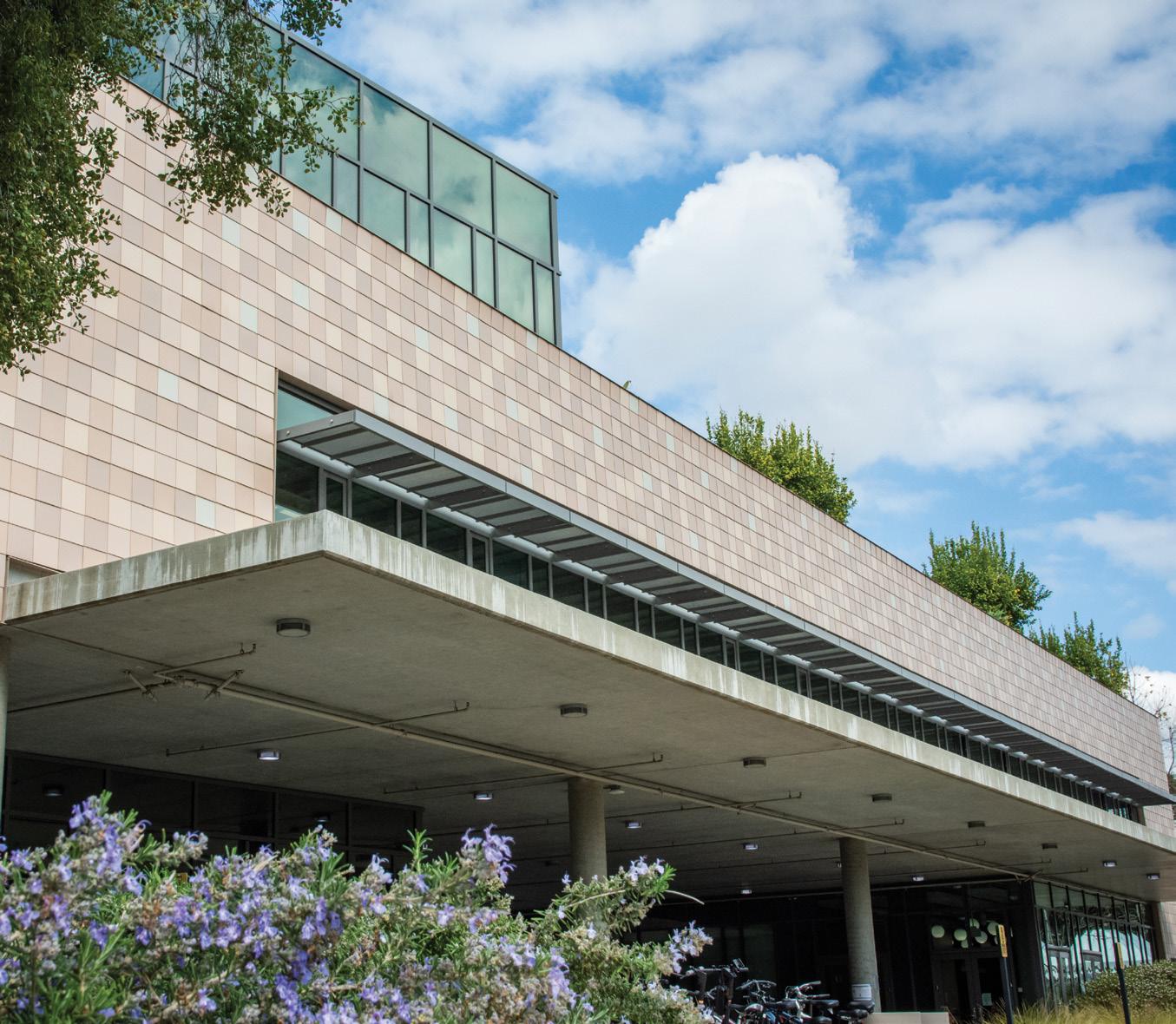
let us embrace this journey with optimism, courage, determination and a shared dedication to excellence. Together, let us continue propelling innovation as we push the frontiers of knowledge and inspire future generations of thinkers and leaders. Together, let’s soar to even greater heights!
– PRESIDENT HARRIET B. NEMBHARD